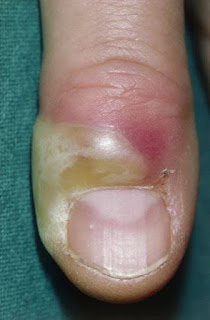Understanding Paronychia: Unveiling the True Nature of "Whitlow”
The term "whitlow" is often colloquially used to describe infections affecting the fingers, but it more accurately refers to a specific condition known as paronychia. Let's delve into the details to unravel the distinction between these terms:
Clarifying the Terminology:
"Whitlow" is a term that has been historically used to describe various finger infections, but in medical terms, it aligns more closely with the condition known as paronychia.
Paronychia Explained:
Paronychia is an infection that targets the soft tissues around the nail, occurring in the nail folds or adjacent skin. It can be either acute, with a sudden onset, or chronic, developing gradually or persisting over time.
Causes of Paronychia:
1. Bacterial Infections: Often caused by bacteria such as Staphylococcus or Streptococcus.
2. Fungal Infections: In some cases, paronychia may be fungal in nature.
Symptoms of Paronychia:
1. Redness and Swelling: Inflammation of the nail folds, leading to redness and swelling.
2. Tenderness and Pain: The affected area is tender to the touch, and pain may be present.
3. Pus Formation: Pus may develop, and in chronic cases, there might be changes in nail shape or color.
Risk Factors for Paronychia:
1. Nail Trauma: Biting nails, finger sucking, or frequent exposure to water can contribute.
2. Manicures: Cuticle trimming during manicures can increase the risk.
Addressing the Misnomer:
While "whitlow" is commonly used to describe finger infections, it's crucial to recognize the accurate terminology. The term more fittingly applies to paronychia, a condition with specific characteristics and causes.
Differentiating from Whitlow:
Whitlow, on the other hand, is associated with the herpes simplex virus (HSV), typically HSV-1. It specifically affects the fingertip, causing pain, redness, and the formation of small blisters filled with clear fluid.
Whitlow (Herpetic Whitlow):
1. Location: Specifically affects the fingertip and involves the soft tissues, including the skin and underlying structures.
2. Causes: Caused by the herpes simplex virus (HSV), typically HSV-1. It often enters the body through breaks in the skin, such as cuts or hangnails.
3. Symptoms: Pain, redness, swelling, and the formation of small, painful blisters filled with clear fluid. Pus may also develop as the infection progresses.
4. Transmission: Highly contagious, and it can be transmitted to other parts of the body or to other individuals through contact with the infected area.
Conclusion:
In summary, what is colloquially referred to as "whitlow" is more accurately identified as paronychia when considering medical terminology. Understanding the distinction ensures proper communication with healthcare professionals for accurate diagnosis and effective treatment. If you suspect a finger infection, seeking medical advice is paramount for a precise evaluation and appropriate intervention.








Comments